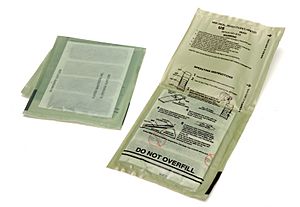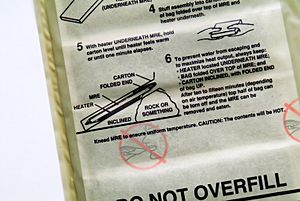Flameless ration heater facts for kids
A flameless ration heater (often called an FRH) is a special packet used to warm up food. You'll often find them with MREs, which are pre-packaged meals, especially for soldiers. The idea is to heat your food without needing a fire or stove. The U.S. military wants these heaters to warm an 8-ounce meal by 100 degrees Fahrenheit in just twelve minutes, and they must not show any flames.
How Do Flameless Heaters Work?
Flameless ration heaters create heat using a clever chemical trick. Inside the packet, there's a fine powder made mostly of magnesium metal. It also has a tiny bit of iron and some regular table salt.
When you add a small amount of water to the heater, the magic begins! The water mixes with the salt to create a salty solution. This solution helps the magnesium and iron react together. Think of it like thousands of tiny, short-circuited batteries. These "mini batteries" quickly produce heat. This process is so powerful that the water inside the heater can quickly reach its boiling point.
One type of heater uses about 7.5 grams of a magnesium-iron mix (95% magnesium, 5% iron) and 0.5 grams of salt. Adding just one ounce of water can heat an 8-ounce meal by 100 degrees Fahrenheit in about 10 minutes. That's enough heat to make your meal nice and warm!
Safety Tips
While flameless heaters are super useful, there's one important thing to know. When they work, they release a small amount of hydrogen gas. This gas isn't usually a problem in open spaces. However, in very small, enclosed areas, like inside an airplane, too much hydrogen gas could be a concern. Because of this, the Federal Aviation Administration (FAA) in the United States has looked into how much gas these heaters release. Their tests showed that the amount of hydrogen gas could be a potential hazard on a passenger aircraft. So, it's best to use them in well-ventilated areas.



